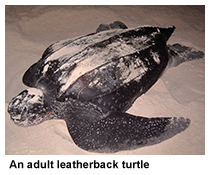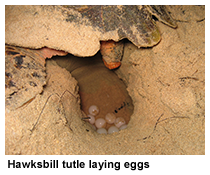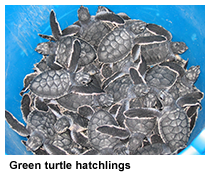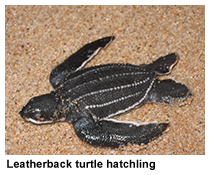Q: How many different types of sea turtle are there?
A:
There are seven different species of sea turtles globally, each of which has a scientific name and a common name. The common name is often a description of some characteristic of the turtle's body. For example, the four most common species in the eastern Caribbean are:
- The green turtle (Chelonia mydas): Named for the green colour of its body fat.
- The hawksbill turtle (Eretmochelys imbricata): Named because of its narrow head and large beak that resembles the beak of a hawk.
- The leatherback turtle (Dermochelys coriacea): The only sea turtle without a bony shell. Its back is covered with a layer of tough, rubbery skin that resembles leather.
- The loggerhead turtle (Caretta caretta): Named because of its exceptionally large head.
The other three species are the olive ridley turtle (Lepidochelys olivacea), the Kemp’s ridley turtle (Lepidochelys kempii) and the flatback turtle (Natator depressus). To learn more about the sea turtles found in the Caribbean, see the WIDECAST Biology page.
Q: What do sea turtles eat?
A:
Sea turtles may eat many different types of food at different life stages, and each species has a specific adult diet.
- Hatchlings and post-hatchlings eat plankton, organic matter, and the plants and animals associated with algae, which float on or near the surface of the ocean..
- Juvenile and adult hawksbills feed off of the reef systems. They primarily eat a variety of sea sponges.
- Juvenile and adult green turtles feed on sea grass and algae.
- Very little is known about juvenile leatherbacks, but adults are known to feed on jellyfish.
Q: When do sea turtles start to breed?
 A: A:
It is thought that female hawksbills in the Caribbean do not start to breed until they are approximately 25-30 years old while adult male hawksbill turtles begin to mate a bit younger, between 20-25 years.
Green turtles are believed to begin breeding at approximately 26-31 years old, while leatherbacks are thought to beginning breeding much earlier than other species, between 9-15 years.
Q: Is it a male or a female?
A:
In the Caribbean, only female turtles come out of the water to nest, so if you see a large turtle on the beach, it is probably a female.
There are no visible external differences between males and females until they reach adulthood. The tail and the size of claws are the only discriminating features between adult male sea turtles and adult females. All juveniles, male or female, have a short tail (a tail that is shorter than, or even with the end of its shell) and short claws that are just visible at the leading edge of the front and hind flippers. However, as the male reaches adulthood, his tail will grow so that it extends well past the end of the shell, and his claws become long and hooked. Adult females, like juvenile sea turtles, have a short tail, and small claws
.
Q: How big do they grow, and how much do they weigh?
A:
Each species of sea turtle grows to a different maximum size. For someone who is used to seeing land turtles (tortoises), a hawksbill turtle may seem huge, while for someone used to seeing leatherback turtles, a hawksbill may seem tiny.
- Hawksbill: 75-100 centimetres (30-39 inches) long, 150-220 pounds (68-100 kilograms).
- Green: 80-125 centimetres (32-48 inches) long, 144-507 pounds (65-230 kilograms).
- Leatherback: 132-180 centimetres (52-71 inches) long, 550-2000 pounds (250-907 kilograms).
Q: How is the nest chamber created?
 A: A:
The female begins the nesting process by using her front and rear flippers to throw away the dry sand around her. She forms a shallow pit around her to prevent the dry sand from constantly filling up the nest cavity that she is trying to dig. Once she has created a 'body pit' she then uses her rear flippers to excavate a nest cavity. She alternates between her right rear and left rear flippers to scoop sand from the nesting chamber. This sand is brought to the surface and is thrown to the side of the nest. She will dig until her rear flippers can no longer reach the deepest portion of the nest. Digging may be abandoned at times due to solid objects such as roots and rocks that prevent her from digging or expanding the nest cavity, as well as movement and/or light disturbances which may scare her back to the sea.
Q: How deep is the nest?
A:
The female hawksbill turtle digs a nest chamber in the sand which is approximately 45 centimetres or 18 inches deep.
The female green turtle digs a nest chamber in the sand which is approximately 80 centimetres or 31 inches deep.
The female leatherback turtle digs a nest chamber in the sand which is approximately 100 centimetres or 39 inches deep.
Q: How many eggs do they lay?
A:
The female hawksbill turtle lays 4-5 clutches of eggs each breeding season. Each clutch of eggs contains an average of 150 eggs.
The female green turtle lays an average of 4 clutches of eggs each breeding season. Each clutch of eggs contains an average of 110 eggs.
The female leatherback turtle lays an average of 7 clutches of eggs each breeding season. Each clutch of eggs contains an average of 85 eggs.
Sea turtles do not breed every year, rather every 2-4 years
Q: How long do the eggs incubate?
A:
Dependent on sand temperature, the eggs will incubate in the sand for 55-75 days, with an average of 60 days for the incubation period.
Q: How do the hatchlings get out of the sand?
 A: A:
In most cases, all the turtle eggs hatch at the same time. All the hatchlings instinctively know to crawl upwards. With the help of all 100-150 of the scrambling hatchlings working together, they slowly make their way up to the surface. It takes between 2-4 days for the hatchlings to emerge from the sand. They gauge their emergence on a cooling sand temperature, which usually indicates nightfall.
Q: How do the hatchlings make it to the sea?
A:
When the hatchlings emerge from the sand, they look for the brightest horizon. Naturally, this horizon should always be the seaward horizon, with or without a moon. In cases where there are brighter lights inland, the hatchlings will orient themselves toward these lights, rather than the seaward horizon, and will travel inland. Here they succumb to predators such as crabs, are run over on roads, or can die from dehydration.
Q: Where do the hatchlings go?
 A: A:
Once the hatchlings make it to the sea, they will begin a 'swimming frenzy' where they swim frantically for approximately 72 hours. They will be picked up and carried by the major currents of the North Atlantic. It is thought that they float on the surface of the ocean for the next 3-4 years, hiding in floating seaweed rafts and travelling wherever the currents take them, before returning to near-shore waters.
Q: How long do they live?
A:
Sea turtles may live for 60+ years. Currently, there is no method to accurately age live adult turtles.
Q: How is the sex of a sea turtle determined?
A:
Studies have determined that the sand temperature during incubation determines the sex of the sea turtle. Warmer temperatures will result in a greater proportion of female hatchlings, where as cooler temperatures will produce a larger number of male hatchlings.
Q: How do they migrate?
A:
Sea turtles migrate mainly using the earth's magnetic field. As a hatchling, the turtle imprints on the location where it was born. Although a turtle will spend the next 20-30 years away from its natal beach, when sexually mature, it is able to migrate back to that site and if it is a female, will most likely nest within a few kilometres distance of where she hatched 30 years earlier.
|





